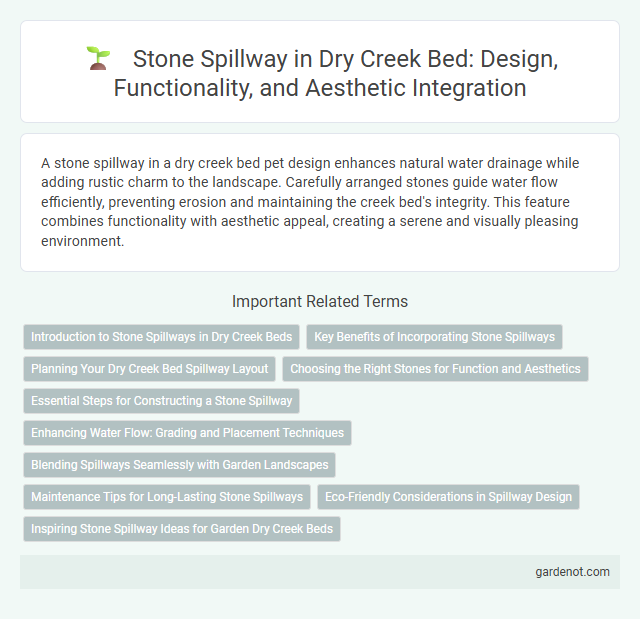A stone spillway in a dry creek bed pet design enhances natural water drainage while adding rustic charm to the landscape. Carefully arranged stones guide water flow efficiently, preventing erosion and maintaining the creek bed's integrity. This feature combines functionality with aesthetic appeal, creating a serene and visually pleasing environment.
Introduction to Stone Spillways in Dry Creek Beds
Stone spillways in dry creek beds serve as controlled channels designed to manage water flow during heavy rainfall. Constructed using durable rocks and strategically placed stones, these spillways prevent soil erosion by efficiently directing runoff. Their natural composition blends seamlessly with the environment while enhancing the stability of creek bed banks.
Key Benefits of Incorporating Stone Spillways
Stone spillways in dry creek beds enhance erosion control by directing water flow efficiently, reducing soil loss and landscape damage. They provide natural filtration, improving water quality by trapping sediments and pollutants during runoff. Incorporating stone spillways also promotes sustainable drainage solutions that blend aesthetically with natural surroundings while requiring minimal maintenance.
Planning Your Dry Creek Bed Spillway Layout
Carefully design your dry creek bed spillway layout by analyzing the natural water flow patterns and topography of your yard to prevent erosion and channel runoff efficiently. Incorporate appropriately sized stones and gravel to create stable steps or cascades that slow water velocity and promote infiltration. Position the spillway so it directs excess water away from foundations and vulnerable areas, ensuring effective drainage during heavy rain events.
Choosing the Right Stones for Function and Aesthetics
Selecting stones with varied sizes and shapes enhances both the function and aesthetics of a dry creek bed stone spillway by ensuring effective water flow and natural appearance. Opt for durable, weather-resistant stones such as granite, basalt, or river rock to withstand erosion and maintain structural integrity. Incorporating smooth and angular stones creates visual interest while providing friction to slow water velocity, reducing erosion risks.
Essential Steps for Constructing a Stone Spillway
Constructing a stone spillway in a dry creek bed begins with accurately surveying the site to determine flow patterns and erosion risks. Using durable, angular rocks, the spillway should be built with a stable foundation and layered to ensure water flows efficiently while preventing soil displacement. Properly sizing and positioning the stone structure is essential to manage stormwater runoff and protect surrounding landscapes from erosion.
Enhancing Water Flow: Grading and Placement Techniques
Stone spillways enhance water flow in dry creek beds by strategically grading the slope to direct runoff efficiently and prevent erosion. Proper placement of angular stones creates durable channels that slow water velocity, allowing controlled drainage and sediment deposition. These techniques optimize water management, reduce soil loss, and maintain the creek bed's structural integrity during heavy rainfall.
Blending Spillways Seamlessly with Garden Landscapes
Stone spillways create natural-looking transitions that enhance the aesthetic of dry creek beds by using locally sourced stones that mimic the surrounding landscape. Integrating permeable materials and layered stone arrangements ensures effective water drainage while maintaining a seamless design flow. Strategic placement of native plants around the spillway further softens edges and promotes ecological harmony within garden landscapes.
Maintenance Tips for Long-Lasting Stone Spillways
Regular inspection of a stone spillway is essential to identify and repair any loose or displaced stones promptly, preventing water erosion and structural damage. Clearing debris and sediment buildup ensures proper water flow and reduces the risk of blockages that can undermine the spillway's stability. Applying sealant to the stones can enhance durability by protecting against weathering and freeze-thaw cycles, extending the lifespan of the stone spillway significantly.
Eco-Friendly Considerations in Spillway Design
Stone spillways in dry creek beds enhance natural water flow while minimizing environmental impact through the use of permeable materials that reduce soil erosion and support groundwater recharge. Eco-friendly spillway design incorporates native stone placement to maintain habitat connectivity and promote biodiversity by providing shelter for aquatic and terrestrial species. Optimizing spillway alignment to follow natural topography further reduces disturbance, allowing for sustainable water management and ecosystem preservation.
Inspiring Stone Spillway Ideas for Garden Dry Creek Beds
Stone spillways in garden dry creek beds create natural drainage paths that prevent erosion while enhancing landscape aesthetics. Using a mix of smooth river stones and larger boulders mimics natural water flow, offering both functionality and visual appeal. Incorporating native plants along the spillway edges further stabilizes soil and complements the rugged stone textures for a harmonious outdoor space.
Stone spillway Infographic

 gardenot.com
gardenot.com